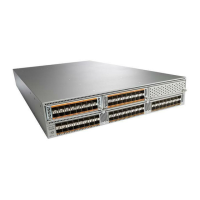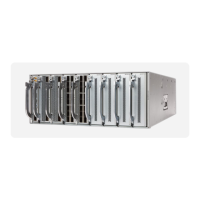If you start a CFS session that requires a network lock but forget to end the session, an administrator can clear
the session. If you lock a network at any time, your username is remembered across restarts and switchovers.
If another user (on the same machine) tries to perform configuration tasks, that user’s attempts are rejected.
Verifying CFS Lock Status
The show cfs lock command displays all the locks that are currently acquired by any application. For each
application the command displays the application name and scope of the lock taken. If the application lock
is taken in the physical scope, then this command displays the switch WWN, IP address, user name, and user
type of the lock holder. If the application is taken in the logical scope, then this command displays the VSAN
in which the lock is taken, the domain, IP address, user name, and user type of the lock holder.
switch# show cfs lock
Application: ntp
Scope : Physical
--------------------------------------------------------------------
Switch WWN IP Address User Name User Type
--------------------------------------------------------------------
20:00:00:05:30:00:6b:9e 10.76.100.167 admin CLI/SNMP v3
Total number of entries = 1
Application: port-security
Scope : Logical
-----------------------------------------------------------
VSAN Domain IP Address User Name User Type
-----------------------------------------------------------
1 238 10.76.100.167 admin CLI/SNMP v3
2 211 10.76.100.167 admin CLI/SNMP v3
Total number of entries = 2
The show cfs lock name command displays the lock details for the specified application.
switch# show cfs lock name ntp
Scope : Physical
--------------------------------------------------------------------
Switch WWN IP Address User Name User Type
--------------------------------------------------------------------
20:00:00:05:30:00:6b:9e 10.76.100.167 admin CLI/SNMP v3
Total number of entries = 1
Committing Changes
A commit operation saves the pending database for all application peers and releases the lock for all switches.
The commit function does not start a session; only a lock function starts a session. However, an empty commit
is allowed if configuration changes are not previously made. In this case, a commit operation results in a
session that acquires locks and distributes the current database.
When you commit configuration changes to a feature using the CFS infrastructure, you receive a notification
about one of the following responses:
• One or more external switches report a successful status—The application applies the changes locally
and releases the network lock.
• None of the external switches report a successful state—The application considers this state a failure
and does not apply the changes to any switch in the network. The network lock is not released.
Cisco Nexus 5600 Series NX-OS System Management Configuration Guide, Release 7.x
42 OL-31641-01
Using Cisco Fabric Services
Committing Changes

